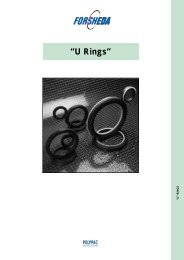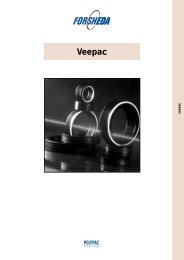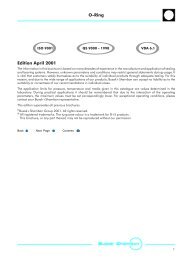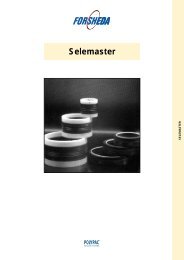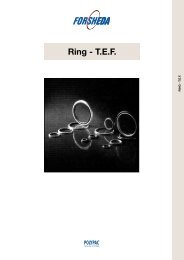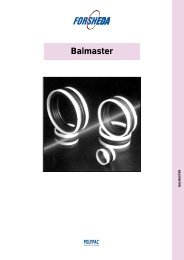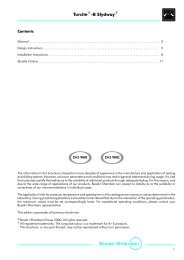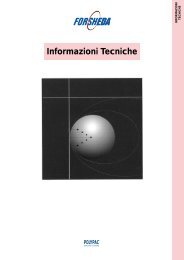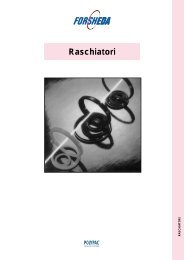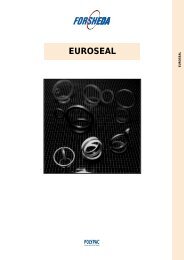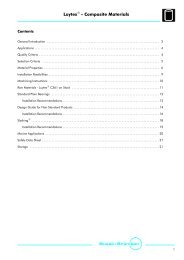Rotary Seals - Dilanda.it
Rotary Seals - Dilanda.it
Rotary Seals - Dilanda.it
You also want an ePaper? Increase the reach of your titles
YUMPU automatically turns print PDFs into web optimized ePapers that Google loves.
V—Ring<br />
Temperature resistance<br />
Exposure to higher temperatures accelerate the ageing of<br />
rubber, the elongation decreases, the compression set<br />
increases, and finally the material becomes hard and<br />
br<strong>it</strong>tle. Cracks at the sealing edge are a typical indication<br />
that the seal has been exposed to excessively high<br />
temperature. The ageing of the rubber has an<br />
appreciable negative influence on the useful life of the<br />
seal.<br />
The temperature lim<strong>it</strong>s for the principal materials are<br />
illustrated in Figure 55. They should only be regarded as<br />
approximate, since the media and time of exposure also<br />
affect the materials.<br />
The temperature ranges w<strong>it</strong>hin the shaded areas indicate<br />
temperatures that can be allowed for only certain periods<br />
of time. The higher the temperature, the shorter the<br />
service life. If the maximum temperature is exceeded, the<br />
elastomer may suffer permanent set or damage. Special<br />
elastomers are available for use in cold temperatures. If the<br />
elastomer is subjected to temperatures lower than the<br />
recommended values <strong>it</strong> will become hard and br<strong>it</strong>tle,<br />
however <strong>it</strong> will regain <strong>it</strong>s properties as soon as the<br />
temperature rises again.<br />
CR<br />
-45 -35 60 120<br />
EPDM<br />
-55 -40<br />
70<br />
-60<br />
-40<br />
NBR<br />
60 115<br />
130<br />
HNBR<br />
-50 -35 90 160<br />
EACM<br />
-35-25 110 180<br />
VMQ<br />
-100 -60 130 220<br />
FKM<br />
-40 -30 150 250<br />
-100 -50 0 +50 +100 +150 +200 +250<br />
Figure 55<br />
Only to be achieved under particular<br />
cond<strong>it</strong>ions w<strong>it</strong>h special materials.<br />
Temperature ° C<br />
Temperature recommendations for V—Rings<br />
Oil and solvent resistance<br />
Since the V—Ring is used primarily for sealing grease<br />
lubricated bearings exposed to water splash, dirt, dust,<br />
scale etc. the normal choice of compound is N<strong>it</strong>rile Rubber<br />
(N6T50) 510. However innumerable types of oil are<br />
available on the market and each of these has different<br />
effect on rubber. In add<strong>it</strong>ion, a given type of oil from<br />
different manufacturers may have different influence.<br />
It is the add<strong>it</strong>ives in the oil that may affect the rubber.<br />
Especially so for hypoid oils, that contain sulphur. Since<br />
sulphur is used as the vulcanising agent for n<strong>it</strong>rile rubber <strong>it</strong><br />
will in<strong>it</strong>iate a secondary curing at temperatures above<br />
+80°C. As a result of that, n<strong>it</strong>rile rubber will become hard<br />
and br<strong>it</strong>tle. Hydrogenated N<strong>it</strong>rile and Fluorinated rubbers,<br />
which are not vulcanised w<strong>it</strong>h sulphur, may therefore be<br />
considered for use w<strong>it</strong>h this type of oil. Oxidised oils<br />
represent another example illustrating the difficulty of<br />
tabulating the oil resistance of rubber materials. These oils<br />
are oxidised during operation and their properties will<br />
therefore change substantially. Such oils break down<br />
silicone rubber. Solvents could generally cause<br />
deterioration or swelling of the rubber however mixtures<br />
of different solvents may cause considerably more damage<br />
than a single solvent. An example of this is mixing<br />
methanol and hydrocarbons.<br />
For further information on oil and solvent resistance we<br />
recommend you to be in contact w<strong>it</strong>h your local B+S<br />
company.<br />
Application instructions<br />
The V-RING is normally fully exposed to the medium to be<br />
sealed. The requirements on the shaft and the counterface<br />
are mainly dependent on the medium and the peripheral<br />
speed.<br />
Shaft design<br />
The V—Ring is in most cases f<strong>it</strong>ted on a rotating shaft. The<br />
requirements regarding diameter tolerances and surface<br />
roughness of the shaft are fairly moderate. As the V—Ring is<br />
an all-rubber seal <strong>it</strong> can be stretched to a varying degree<br />
and be used for a wide range of shaft diameters.<br />
In applications where low power loss and long lifetime are<br />
important <strong>it</strong> is recommended that the V—Ring size is<br />
selected, so that the shaft diameter falls between the<br />
minimum and nominal values w<strong>it</strong>hin the recommended<br />
range. This is because the contact pressure of the sealing lip<br />
increases w<strong>it</strong>h the shaft diameter, due to the stretch of the<br />
V—Ring. At a higher stretch, a harder contact pressure is<br />
generated, causing an accelerated wear of the sealing lip.<br />
In order to prevent the V—Ring from sliding along the shaft,<br />
and to ensure the correct installation width, <strong>it</strong> is always<br />
146<br />
Latest information available at www.busakshamban.com<br />
Ed<strong>it</strong>ion April 2006



